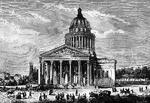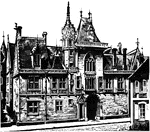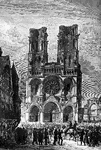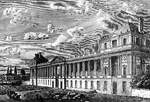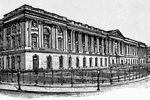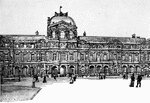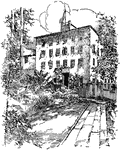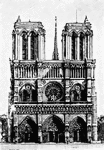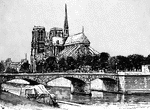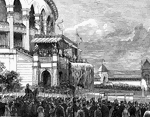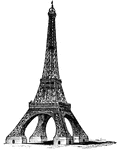The French Buildings and Monuments ClipArt gallery offers 149 illustrations of churches, cathedrals, government buildings, castles, monuments, and other famous French structures.
![The Musée du Louvre or officially the Grand Louvre — in English, the Louvre Museum or Great Louvre, or simply the Louvre — is the national museum of France, the most visited museum in the world, and a historic monument. It is a central landmark of Paris, located on the Right Bank of the Seine in the 1st arrondissement (neighborhood). Nearly 35,000 objects from the 6th century BC to the 19th century are exhibited over an area of 60,600 square meters (652,300 square feet).Charles Le Brun (February 24 1619 – February 22 1690) was a French painter and art theorist, one of the dominant artists in 17th century France."Little by little a method of ornamentation was introduced by successive decorators and architects, which was eminently suited to the French taste. Androuet Du Cercean and Jean Lepautre are especially noticeable as representatives of this school of establishment. The sumptuous Apollo Gallery in the Louvre is a characteristic example of the productions of the latter. [This image] exhibits a portion of the system of decoration which pervades the whole gallery."](https://etc.usf.edu/clipart/73700/73725/73725_lebrun_charl_mth.gif)
Fragment from the Apollo Gallery in the Louvre at Paris
The Musée du Louvre or officially the Grand Louvre — in English, the Louvre Museum or Great Louvre,…

Gable at Notre Dame de Paris
"Gable of the South Transept Door of Notre Dame, Paris; 13th century." -Whitney, 1911

Galleries of Cathedral of Amiens
"Galleries of the west front of the Cathedral of Amiens, 13th century, illustrating treatment of galleries…
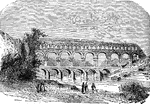
Pont du Gard
The Pont du Gard is an aqueduct and bridge that was built over the Gard River by the Roman Empire. It…
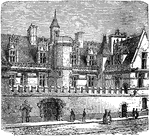
Hotel de Cluny
An illustration of the Hotel de Cluny in Paris, France. The Hotel de Cluny is a small palace from the…
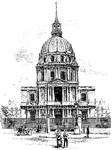
Church of the Hotel des Invalides
An illustration of the Church of the Hotel des Invalides located in the 7th arrondissement of Paris,…
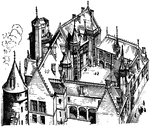
Hotel Jacques Coeur, Bourges
The same gothic principles controlled the designing of houses, farm buildings, barns, granaries, and…
!["The French town houses differ, moreover, essentially in entire design, which influences their style, from those of other countries. This remark does not apply to those houses which are calculated for one family only, nor to the palatial residences of the nobility and plutocracy, which the French call Hôtels. This difference partly consists in the universal employment of the ground-floor as shops, which are only separated from the street by an opening which is glazed over and supported by individual iron girders. The whole façade consequently appears rather to be suspended in the air than supported architecturally. Over the shop, there is almost always an entresol, that is to say, a low storey between the ground floor and the first storey. The restriction to a certain height which the façade may not exceed has a determinating influence on the form of the topmost portion of the building, inasmuch as above this height the façade is terminated by an offset which slopes backwards over the upper storey [shown here]. Projecting balconies are, moreover, usual along the whole length of the façades, making the divisions into storeys. When these balconies are not met with, the windows of each storey come down to the top of the storey below, or at any rate nearly so, and have iron balustrades in front of them; this construction is partly owing to the storeys from their great number being so low that without this remedy the windows would appear too small and badly proportioned. The lowness of the storeys necessarily exercises a prejudicial effect on the architectural beauty of the façades; so that it is difficult to impart any structural significance to the houses, which consequently only convey and sense of beauty through their details."](https://etc.usf.edu/clipart/73800/73805/73805_house_paris_mth.gif)
Façade of a House in Paris
"The French town houses differ, moreover, essentially in entire design, which influences their style,…
![Les Invalides in Paris, France, is a complex of buildings in the city's 7th arrondissement containing museums and monuments, all relating to the military history of France, as well as a hospital and a retirement home for war veterans. The buildings house the Musée de l'Armée, the military museum of the Army of France, the Musée des Plans-Reliefs, and the Musée d'Histoire Contemporaine, as well as the burial site for some of France's war heroes, notably Napoleon Bonaparte."The principal architectural activity of this period was displayed by Jules Hardouin Mansard, who was head architect to the king and the head of the influential school, as Lenôtre at the same time was principal horticulturist. Mansard built the palaces of Versailles (1647-1708, Marly, the Grand Trianon, as also the Invalides at Paris [shown here]."](https://etc.usf.edu/clipart/73700/73748/73748_invalides_mth.gif)
Invalides at Paris
Les Invalides in Paris, France, is a complex of buildings in the city's 7th arrondissement containing…
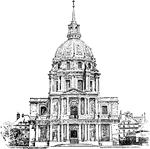
Hôtel des Invalides
A complex of buildings containing museums and monuments, all relating to the military history of France.…

Colonne Juillet
"The Bastille, after its capture in 1789, was leveled to the ground, and its stones were used to build…

The Louvre and the Tuileries
"The palace of the Louvre was begun by Francis I in the sixteenth century and continued by his successors,…
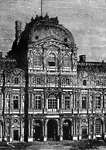
Louvre West Pavilion
"Louvre is the name of a celebrated public building of Paris, situated in the N. part of the city, near…

Bird's Eye View of the Louvre
An illustration of the Louvre Museum in Paris, France from a bird's-eye view. The Louvre is one of the…
!["The change from the pure to the later Renaissance, which was formerly seen only in individual instances, has now received a certain extension. This is mainly owing to the key-note struck in the New Louvre [shown here], begun by Visconti, but finished by another architect. Although it is true that the new building conforms in general to the architecture of the Old Louvre, yet still an increase rather than a decrease is to be perceived in the effort for picturesque effect, in the licence of the Roccoco style, and in an unstructural treatment of the individual forms and ornamental parts."](https://etc.usf.edu/clipart/73800/73804/73804_louvre_corne_mth.gif)
Corner Pavilion of the New Louvre
"The change from the pure to the later Renaissance, which was formerly seen only in individual instances,…
![The Musée du Louvre or officially the Grand Louvre — in English, the Louvre Museum or Great Louvre, or simply the Louvre — is the national museum of France, the most visited museum in the world, and a historic monument. It is a central landmark of Paris, located on the Right Bank of the Seine in the 1st arrondissement (neighborhood). Nearly 35,000 objects from the 6th century BC to the 19th century are exhibited over an area of 60,600 square meters (652,300 square feet).The Louvre was built by "three prominent architects, [one of which was] Pierre Lescot (1510-1578), who desiged the celebrated Western Façade of the Louvre [shown here]."](https://etc.usf.edu/clipart/73700/73722/73722_louvre_facad_mth.gif)
Inner Façade of the Louvre
The Musée du Louvre or officially the Grand Louvre — in English, the Louvre Museum or Great Louvre,…
![The Musée du Louvre or officially the Grand Louvre — in English, the Louvre Museum or Great Louvre, or simply the Louvre — is the national museum of France, the most visited museum in the world, and a historic monument. It is a central landmark of Paris, located on the Right Bank of the Seine in the 1st arrondissement (neighborhood). Nearly 35,000 objects from the 6th century BC to the 19th century are exhibited over an area of 60,600 square meters (652,300 square feet).The Louvre was built by "three prominent architects, [one of which was] Pierre Lescot (1510-1578), who desiged the celebrated Western Façade of the Louvre [shown here]."](https://etc.usf.edu/clipart/73700/73723/73723_louvre_facad_mth.gif)
Inner Façade of the Louvre
The Musée du Louvre or officially the Grand Louvre — in English, the Louvre Museum or Great Louvre,…
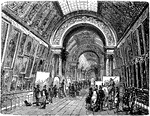
Gallery in the Louvre
An illustration of one of the galleries in the Louvre in Paris, France. The Louvre is one of the world's…
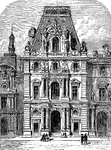
The Richelieu Pavilion of the Louvre
The Richelieu Pavilion (a pavilion located on the inside "court") of the Louvre Palace. The Richelieu…
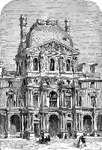
Turgot Pavilion of the New Louvre
Located in the New Louvre, the name given to the wings and pavilions extending from the main body. The…

Luxembourg Palace
An illustration of Luxembourg Palace which is located in Paris, France. The Luxembourg Palace houses…
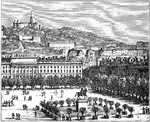
The City of Lyons, France
Lyons-la-Forêt is a commune in the Eure department in Normandy, in northern France. Because of…

La Madeleine
"Begun by Napoleon in 1806; not completed until 1842. The emperor planned it as a 'of fame' to commemorate…
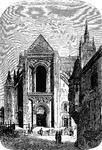
Cathedral of Mans
The Cathedral of Mans is a Roman Catholic Cathedral located in Le Mans, France. The Cathedral was built…
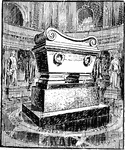
Sarcophagus of Napoleon Bonaparte
An illustration of the sarcophagus of Napoleon Bonaparte located in the Church of the Hotel des Invalides.
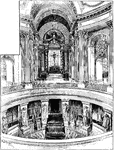
Tomb of Napoleon Bonaparte
An illustration of the tomb of the sarcophagus of Napoleon Bonaparte located in the Church of the Hotel…
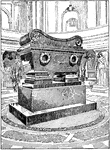
The Tomb of Napoleon
"In 1840 Napoleon's body was removed from St. Helena, taken with great pomp to Paris, and deposited…
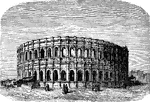
The Arena of Nîmes
The arena of Nîmes is a Roman amphitheater located in city of Nimes, France. The amphitheater was built…
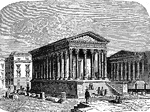
The Square House of Nîmes
The square house of Nîmes is also known as Maison Carree. It is an ancient Roman temple located in…

Notre Dame
"The present structure, begun in 1163 and completed about 1240, suffered severely during the French…
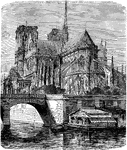
Notre Dame Cathedral
An illustration of Notre Dame Cathedral in Paris, France. This building is also known as Notre Dame…

Openwork Gable, From Front of Rouen Cathedral
A gable is the generally triangular portion of a wall between the edges of a sloping roof. A wimperg…

Opera House
An illustration of The Opera House in Paris, France. It is commonly known as the Paris Opera. This Opera…

View of the Opera House in Paris
The Palais Garnier, also known as the Opéra de Paris or Opéra Garnier, but more commonly as the Paris…

Petit Palais
The Petit Palais (Small Palace) is a museum in Paris, France. It was built for the Universal Exhibition…
![The Panthéon (Latin Pantheon, from Greek Pantheon, meaning "Every god") is a building in the Latin Quarter in Paris, France. It was originally built as a church dedicated to St. Genevieve, but after many changes now combines liturgical functions with its role as a famous burial place. It is an early example of Neoclassicism, with a façade modeled on the Pantheon in Rome, surmounted by a small dome that owes some of its character to Bramante's "Tempietto". Located in the 5th arrondissement on the Montagne Sainte-Geneviève, the Panthéon looks out over all of Paris. Its architect, Jacques-Germain Soufflot, had the intention of combining the lightness and brightness of the gothic cathedral with classical principles. Soufflot died before his work was achieved, and his plans were not entirely followed. The transparency he had planned for his masterpiece was not attained. Nevertheless, it is one of the most important architectural achievements of its time and the first great neoclassical monument."Toward the end of the reign of Louis XV. a reaction set in, which was caused partly by the excess and caprice displayed in the application of this style, and partly by the tide again setting in the direction of the antique. This evidence by the Colonnades de la Place de Concorde, and by the Church of Ste. Geneviève, which was begun by Soufflot in the year 1755, and subsequently received the name of Pantheon [shown here]. From thenceforth imitations of ancient buildings came into vogue, as they also did in other countries."](https://etc.usf.edu/clipart/73700/73751/73751_pantheon_mth.gif)
West Front of the Pantheon at Paris
The Panthéon (Latin Pantheon, from Greek Pantheon, meaning "Every god") is a building in the Latin…

Paris Opera House
The Paris Opera House was built by architect Charles Garnier, who was chosen by Emperor Napoleon III.…
![The Musée du Louvre or officially the Grand Louvre — in English, the Louvre Museum or Great Louvre, or simply the Louvre — is the national museum of France, the most visited museum in the world, and a historic monument. It is a central landmark of Paris, located on the Right Bank of the Seine in the 1st arrondissement (neighborhood). Nearly 35,000 objects from the 6th century BC to the 19th century are exhibited over an area of 60,600 square meters (652,300 square feet)."Du Cerceau, who flourished during the reign of Henry IV., connected the block of buildings which belong to the Louvre, and had been constructed under Catherine dei Medici, by a gallery with the Tuileries. This architect abandoned the characteristic feature of the French Renaissance, which had prevailed hitherto, namely, of giving its peculiar columnar order to each storey, and assimilated his designs to those of the late Roman Renaissance, in which a striking effect was produced at the expense of truth by continuous columns and pilasters extending over several storeys and rows of windows.Although Du Cerceau was obligated to leave France in the year 1604, the impulse which he had given in the direction of the above-mentioned manner led to its being generally adopted. The new buildings were more correct, but less picturesque than those built during the earlier period of the French Renaissance, and a certain insipidity seems to characterize the various structures erected during the reigns of Henry IV., and especially Louis XIII. As is shown [here], a combination of free-stone and brick was restored to in such a way that the former was employed for the mouldings, and for the quoins and dressings of the doors and windows, whilst brick was used for the spaces between. In the case of the windows the free-stone introduced assumed the forms of quoins. If ornamentation had been previously excessive, it now retired into the background, and was only employed in moderation; and the method of its treatment began to be distinguished from that of the former period. The forms of the details above all began to lose in purity: rustications were inappropriately introduced in the walls and columns, and the roofs were made high and steep, which gave the rest of the building a heavy and squat appearance, whilst the numerous turret-shaped chimneys, which were necessitated by these high roofs, formed a peculiar feature in the construction."](https://etc.usf.edu/clipart/73700/73746/73746_royal_palace_mth.gif)
Paris, Royal Palace Façade
The Musée du Louvre or officially the Grand Louvre — in English, the Louvre Museum or Great Louvre,…
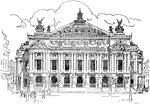
The Opera, Paris
"Erected 1861-1875. Covers nearly three acres and cost $7,000,000. A huge dome extends over the auditorium.…

Pavilion of the Tuileries
"Central Pavilion of the Tuileries, as designed by De Lorme (from Mariette)." — Chambers, 1881
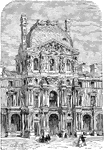
The Turgot Pavilion
The Turgot Pavilion is part of the Louvre Palace which is located along the Seine river in Paris, France.…

Pillar from the Cathedral of Tours
A pillar from the Cathedral of Tours in France, circa 13th century.
